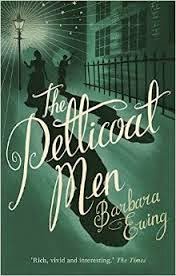GREAT READS FOR FEBRUARY, 2015
The Petticoat Men, by Barbara Ewing
In 1870, a scandalous
trial was conducted in London’s Old Bailey:
two young men of good family were charged with parading as women in
public places. As if that weren’t
salacious enough, later charges of sodomy were brought against Ernest Poulton
and Frederick Park, who swore that they only wore women’s clothing in their
roles as actors in various revues: ‘we
are not guilty of these shocking and scurrilous charges, sirs!’
But who doesn’t love a scandal? The tabloids were just as industrious 145
years ago as they are today, and Victorian gossipmongers delighted in anything
printed about The Men in Petticoats, not least because Park and Poulton weren’t
the usual Hoi Polloi; they had
connections, especially to the Nobility:
how delicious to read (if you could) that the Upper Classes had their
fair share of deviates, in spite of their impassioned denials.
Author Barbara Ewing has reconstructed as a novel The
Crime of the Century, fleshing out Ernest, too beautiful to be a man, and
Frederick, the second son of an eminent lawyer to be charged with buggery – and
the more humble people they affected with their charades: the Stacey family, from whom both men rented
a room casually – ‘We just need a place to store our gowns and change into them
occasionally, dears!’, and the consequences of their deceit on Mattie, daughter
of the landlady, and champion of them both in the courtroom – until she is
forced to concede that her idols have feet of clay, especially when their
lodging house is covered with graffiti and she is branded a crippled whore.
As the trial progresses, it becomes clear that powerful
people will do much to keep the details of Ernest and Freddie’s indiscretions
to a minimum – who cares who gets trampled upon in the process, as long as the
Great and the Good are not exposed:
small fry like the Stacey family are entirely expendable - but Ms Ewing
has done a marvellous job of convincing the reader that justice eventually
prevailed, despite the lamentable double standards and hypocrisies of the
age. Her characters smile at us from the
pages, damaged, ebullient, charming and villainous: this novel, the facts meticulously
researched, reads like a thriller, as thrilling as the real case of The Men in
Petticoats 145 years ago. Ms Ewing
presents a compelling portrait of the times:
God-fearing, strait-laced on the surface – and embracing a netherworld
of corruption beneath. Highly
recommended.
The
Mountaintop School for Dogs, by Ellen Cooney
Blurbs by famous authors on book covers can sometimes
achieve the opposite of what they intend, which is to convince the reader to
read said book. When I read ‘this book
will grab your heart and not let go’ my toes curled: oh dear, yet another heartwarming tale
guaranteed to be forgotten five minutes after it’s finished.
Well,
I decided anyway to give Ellen Cooney’s heartwarmer a try; I haven’t read anything else of hers and I
thought (meanly) that I didn’t have to finish it if it was too saccharine.
So! I humbly stand corrected: Ms Cooney’s story is indeed heartwarming, but
in the best possible way, for her characters are all too real, too credible and
broken to not remind us of ourselves or of people we know. This little book is a gem.
Evie
(we never know her last name) applies online to become an apprentice dog trainer
at a dog rescue sanctuary in a remote mountain town (name or State never
mentioned). She is searching for a
career, a long term vocation, something that will fulfil her need to use her
high intelligence, to make a difference to – anything, or anybody. Even though she has never had a pet and knows
nothing of dogs, Evie feels she has to remove
herself from her present environment, and what better way to start afresh than
somewhere no-one would think to look; a place where the occupants would require
her help, not the other way round, as it is at present.
And
the occupants do need help – lots of it, from the little Scottish terrier who
was abandoned to starve in an apartment by her owners when they left rather
than pay the outstanding rent; the
Rotweiler who was pushed out of her owner’s car and ran after it for miles
before giving up; the wee terrier who
was also abandoned as soon as a baby came along to replace her. And so on.
And so on. Evie’s initial task is
to make friends with these dogs who no longer trust humans, to restore their
faith in the goodness of humans – to help them to feel like Man’s Best Friend
again. For Evie this is a tall
order. She has never been best friends
with anyone. But perhaps that fact
eventually gives her a better insight into the ways a rejected and crushed
personality feels: Evie knows all about
rejection.
And
the longer she stays at the Sanctuary, she realises that it’s not only the
animals who need the affirmation of friendship and affection; everyone who is employed there has their own
story to tell, their own reasons for being there. The Sanctuary is a haven for all those who are sore of heart and
tired of spirit, but united by their common wish to make their world a better
place for animals – and themselves.
Evie
is asked at the beginning of her stay to explain her reasons for wanting to
work at the Sanctuary, and because she has been rather less than honest in her
application, she delays her answer as long as she can – then, finally she
thinks to write this:
Came
in as a stray,
Is
not completely hopeless,
Please
allow to stay.
Well
done, Ms Rooney. This is a lovely
story. Highly recommended.



No comments:
Post a Comment